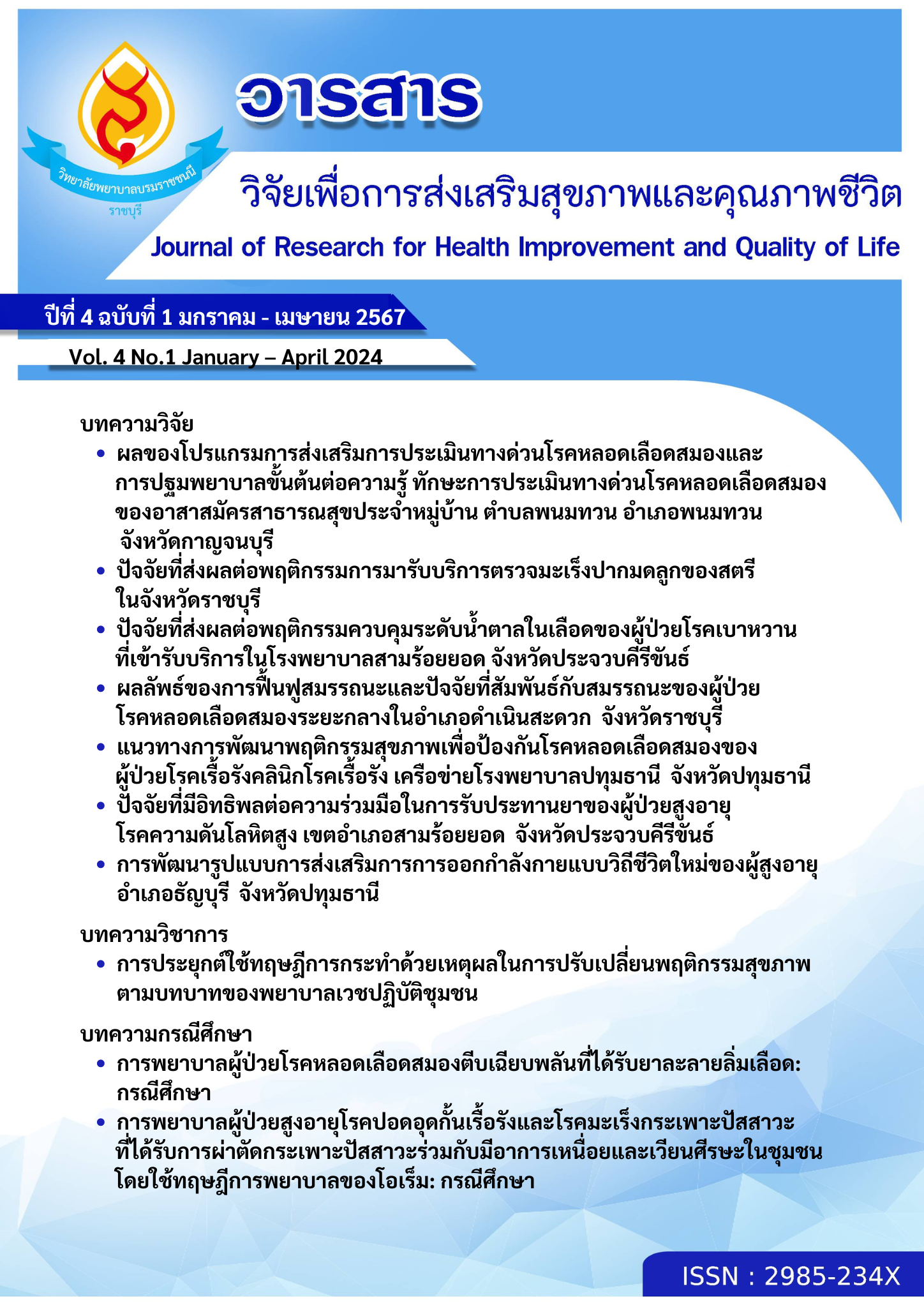ผลลัพธ์ของการฟื้นฟูสมรรถภาพและปัจจัยที่มีความสัมพันธ์กับสมรรถภาพของผู้ป่วยโรคหลอดเลือดสมองระยะกลางในอำเภอดำเนินสะดวก จังหวัดราชบุรี
คำสำคัญ:
โรคหลอดเลือดสมอง, การฟื้นฟูระยะกลาง, ผลลัพธ์การฟื้นฟูบทคัดย่อ
การศึกษานี้เป็นการศึกษาเชิงวิเคราะห์แบบย้อนหลังมีวัตถุประสงค์การวิจัยเพื่อวัดผลลัพธ์ของการฟื้นฟูสมรรถภาพและศึกษาปัจจัยที่มีความสัมพันธ์กับสมรรถภาพของผู้ป่วยโรคหลอดเลือดสมองระยะกลางในรูปแบบการเยี่ยมบ้าน ตั้งแต่วันที่ 1 กันยายน 2565 – 31 สิงหาคม 2566 คัดเลือกกลุ่มตัวอย่างตามเกณฑ์จำนวน 40 คน เครื่องมือวิจัยเป็นแบบประเมินความสามารถในการทำกิจวัตรประจำวันดัชนีบาร์เธล วิเคราะห์ข้อมูลโดยใช้สถิติเชิงพรรณนา การทดสอบค่าที และการทดสอบของฟิชเชอร์ ผลการศึกษา พบว่า
1. ค่าเฉลี่ยคะแนนบาร์เธลหลังเยี่ยมบ้านเทียบกับก่อนเยี่ยมบ้านเพิ่มขึ้นอย่างมีนัยสำคัญทางสถิติ (p<.01) ค่าสมรรถภาพเพิ่มขึ้นเฉลี่ย 7.25±4.8 คะแนน ค่าประสิทธิผลของการฟื้นฟูสมรรถภาพเฉลี่ยร้อยละ 69.66±36.29
2. ปัจจัยที่มีความสัมพันธ์กับสมรรถภาพอย่างมีนัยสำคัญทางสถิติ ประกอบด้วย 7 ปัจจัย ได้แก่ ดัชนีมวลกาย (p<.05) ระดับกำลังกล้ามเนื้อแขนหลังฟื้นฟูสมรรถภาพ (p<.01) ระดับกำลังกล้ามเนื้อขาหลังฟื้นฟูสมรรถภาพ (p<.01) การมีภาวะแทรกซ้อน (p<.01) ปอดติดเชื้อ (p<.05) แผลกดทับ (p<.01) และข้อติด (p<.05)
ดังนั้นทีมเยี่ยมบ้านจึงควรปรับปรุงการบริการฟื้นฟูให้ดียิ่งขึ้น เช่น การส่งเสริมโภชนาการให้เพียงพอ การออกกำลังกายแบบเน้นการเพิ่มความแข็งแรงของกล้ามเนื้อ และการให้ความรู้ในการป้องกันภาวะแทรกซ้อนต่างๆเพื่อช่วยเพิ่มความสามารถในการทำกิจวัตรประจำวันของผู้ป่วย
เอกสารอ้างอิง
Akazawa, N., Harada, K., Okawa, N., Tamura, K., & Moriyama, H. (2019). Low body mass index negatively affects muscle mass and intramuscular fat of chronic stroke survivors. PLOS ONE, 14(1), 1-12. https://doi.org/10.1371/journal.pone.0211145
Charoendee, K., Boribun, N., Butchumsaeng, A., & Rungrueang, S.(2022). Annual report of non-communicable diseases 2022. Bangkok: Aksorn graphic and design. (in Thai)
Che, B., Shen, S., Zhu, Z., Wang, A., Xu, T., Peng, Y., Li, Q., Ju, Z., Geng, D., Chen, J., He, J., Zhang, Y., & Zhong, C. (2020). Education level and long‐term mortality, recurrent stroke, and cardiovascular events in patients with ischemic stroke. Journal of the American Heart Association, 9(16), 1-12. https://doi.org/10.1161/jaha.120.016671
Deepradit, S., Powwattana, A., Lagampan, S., & Thiangtham, W. (2023). Effectiveness of a family-based program for post-stroke patients and families: A cluster randomized controlled trial. International Journal of Nursing Sciences, 10(4), 446-455.
Department of Medical Services. (2020). Guideline for intermediate care in the elderly. Bangkok: Beyond publishing Co.Ltd. (in Thai)
Department of Older Persons. (2023). Number of elderly people in Thailand by province 2023. http://www.dop.go.th/th/statistics_page?cat=1&id=2. (in Thai)
Hsieh, Y.-W., Wang, C.-H., Wu, S.-C., Chen, P.-C., Sheu, C.-F., & Hsieh, C.-L. (2007). Establishing the minimal clinically important difference of the barthel index in stroke patients. Neurorehabilitation and Neural Repair, 21(3), 233–238.
Jungjaroennorasook, N. (2022). Factors affecting poor functional outcomes of intermediate care rehabilitation in post-stroke patients. J Thai stroke Soc, 21(3), 19-30. (in Thai)
Kaeowichian, N., Chuenklin, T., & Koetwichai, W. (2021). Intermediate care policy in Thailand: What should be done?. Journal of Health Science, 30(5), 894-906.
Kongsawasdi, S., Klaphajone, J., Wivatvongvana, P., & Watcharasaksilp, K. (2019). Prognostic factors of functional outcome in ischemic stroke during 6 months after onset. J Clin Med Res, 11(5), 375-382.
Kuptniratsaikul, V., et al. (2016). The Effectiveness and efficiency of inpatient rehabilitation services in Thailand: a prospective multicenter study. Rehabil Process Outcome, 2016(5), 13-18.
Lohanchun, B., et al. (2017). Standard rehabilitation services. Nonthaburi: Sahamitr Printing and Publishing company. (in Thai)
Lohanchun, B., et al. (2019). Guideline for intermediate care (service plan). Samut Sakhon: Born to be publishing. (in Thai)
Maneechot, B., & Sasat, S. (2019). Selected factors related to physical functional ability among stroke older persons. Journal of Nursing Science Chulalongkorn University, 31(3), 87-100. (in Thai)
Matsakunphan, P., Saringkharinakun, T., Riothong, K., Thimayom, P., & Wichianphaisan, P. (2016). Clinical practice guidelines for stroke rehabilitation. Bangkok: Tana Press and Graphic. (in Thai)
Pattanasuwanna, P., (2019). Outcomes of intermediate phase post-stroke inpatient rehabilitation in community hospital. ASEAN J Rehabil Med, 29(1), 8-13.
Pipatsrisawat, S., (2020). Outcomes of rehabilitation in intermediate phase of stroke patients. Chiangrai medical journal, 12(3), 47-56. (in Thai)
Saligupta, P., (2023). Clinical factors related to good functional outcome of patients in intermediate care program in Chiangrai provice. Chiangrai medical journal, 15(3), 88-99. (in Thai)
Sathapornsathid, A., (2021). Outcomes of rehabilitation in acute ischemic stroke patients receiving thrombolytic injection compared with non-thrombolytic group. Region 4-5 Medical Journal, 40(2), 241-253. (in Thai)
Thiamkao, S. (2022). Incidence of stroke in Thailand. Thai journal of Neurology, 39(2), 39-46. (in Thai)
ดาวน์โหลด
เผยแพร่แล้ว
ฉบับ
ประเภทบทความ
สัญญาอนุญาต
ลิขสิทธิ์ (c) 2024 วิทยาลัยพยาบาลบรมราชชนนี ราชบุรี

อนุญาตภายใต้เงื่อนไข Creative Commons Attribution-NonCommercial-NoDerivatives 4.0 International License.
บทความทีตีพิมพ์ในวารสารนี้ถือว่าเป็นลิขสิทธิ์ของวิทยาลัยพยาบาลบรมราชชนนี ราชบุรี และผลงานวิชาการหรือวิจัยของคณะผู้เขียน ไม่ใช่ความคิดเห็นของบรรณาธิการหรือผู้จัดทํา




